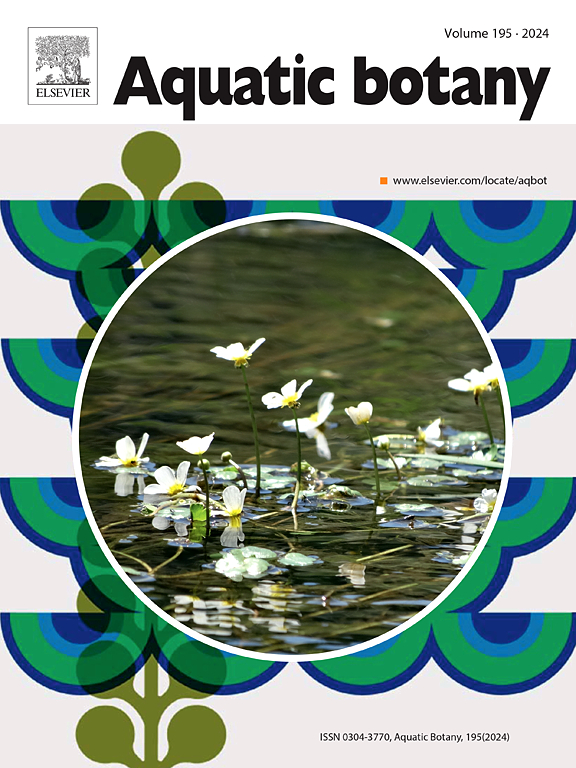Genetic diversity and population structure of four Trapa species from the Yangtze River and Amur River basins, China
IF 2.6
4区 生物学
Q2 MARINE & FRESHWATER BIOLOGY
引用次数: 0
Abstract
Water chestnuts (Trapa L.) are annual floating-leaved macrophytes with significant economic and ecological values. Genetic information assessment of wild germplasm resources is essential to the effective utilization and cultivation breeding of this genus. Here, Expressed Sequence Tag-Simple sequence repeat (EST-SSR) markers were developed and used to evaluate the genetic diversity and population structure of the four common wild Trapa species from the two diversity centers of Trapa in China: the Yangtze River Basin (YRB) and the Amur River Basin (ARB). For the 12,178 EST-SSRs, the dinucleotide (55.3 %) was the predominant type. Using 19 primers, higher levels of genetic variation were detected in the two Trapa species from YRB (T. bispinosa: He= 0.530; T. quadrispinosa: He=0.498) than that of the species from ARB (T. manshurica: He = 0.279; T. maximowiczii: He=0.415). This might be attributed to the smaller population size and lower hydrological connectivity among populations for the two species of ARB. Correspondingly, the population differentiation levels within the two Trapa species in ARB (T. manshurica: FST=0.383; T. maximowiczii: FST=0.239) were higher than that of the species in YRB (T. bispinosa: FST=0.169; T. quadrispinosa: FST=0.124). The clustering analyses (UPGMA, PCoA and SRUCTURE) consistently showed that all the individuals were divided into three branches: the accessions from T. maximowiczii and T. manshurica were clustered based on their species origins; the same genetic group was shared by the individuals from T. bispinosa and T. quadrispinosa, which possessed similar fruit morphological characteristics in addition to the number of waist horns. Findings of this study suggested the Trapa populations with high genetic diversity should be prioritized for conservation in YRB, while each population should be equally protected because of obvious genetic differentiation among populations in ARB.
中国长江流域和阿穆尔河流域 4 个 Trapa 种的遗传多样性和种群结构
菱角是一年生浮叶大型植物,具有重要的经济和生态价值。野生种质资源的遗传信息评价是该属植物有效利用和栽培育种的基础。本研究利用EST-SSR(表达序列标签-简单序列重复)标记,对中国两个水豚多样性中心:长江流域(YRB)和阿穆尔河流域(ARB)的4种常见水豚野生物种的遗传多样性和种群结构进行了分析。在12178个EST-SSRs中,二核苷酸(55.3% %)为优势型。利用19条引物,检测到两种不同种类的遗传变异较高(He= 0.530;四足棘球绦虫:He=0.498)比ARB种(满水棘球绦虫:He= 0.279;T. maximowiczii: He=0.415)。这可能是由于两种ARB种群规模较小,种群间水文连通性较低所致。与之相对应的是,在ARB (T. manshurica)中,两种Trapa物种间的种群分化水平:FST=0.383;最大氏盲蝽(T. maximowiczii): FST=0.239)高于长江区(T. bispinosa: FST=0.169;四棱棘球绦虫:FST=0.124)。聚类分析(UPGMA、PCoA和structure)一致表明,所有个体均可划分为3个支系:以种源为聚类依据的是T. maximowiczii和T. manshurica;两种果实的形态特征和腰角数量相似,属于同一遗传群。本研究结果表明,遗传多样性高的Trapa居群应优先保护,同时由于ARB居群间遗传分化明显,每个居群应得到同等保护。
本文章由计算机程序翻译,如有差异,请以英文原文为准。
求助全文
约1分钟内获得全文
求助全文
来源期刊

Aquatic Botany
生物-海洋与淡水生物学
CiteScore
3.80
自引率
5.60%
发文量
70
审稿时长
6 months
期刊介绍:
Aquatic Botany offers a platform for papers relevant to a broad international readership on fundamental and applied aspects of marine and freshwater macroscopic plants in a context of ecology or environmental biology. This includes molecular, biochemical and physiological aspects of macroscopic aquatic plants as well as the classification, structure, function, dynamics and ecological interactions in plant-dominated aquatic communities and ecosystems. It is an outlet for papers dealing with research on the consequences of disturbance and stressors (e.g. environmental fluctuations and climate change, pollution, grazing and pathogens), use and management of aquatic plants (plant production and decomposition, commercial harvest, plant control) and the conservation of aquatic plant communities (breeding, transplantation and restoration). Specialized publications on certain rare taxa or papers on aquatic macroscopic plants from under-represented regions in the world can also find their place, subject to editor evaluation. Studies on fungi or microalgae will remain outside the scope of Aquatic Botany.
 求助内容:
求助内容: 应助结果提醒方式:
应助结果提醒方式:


